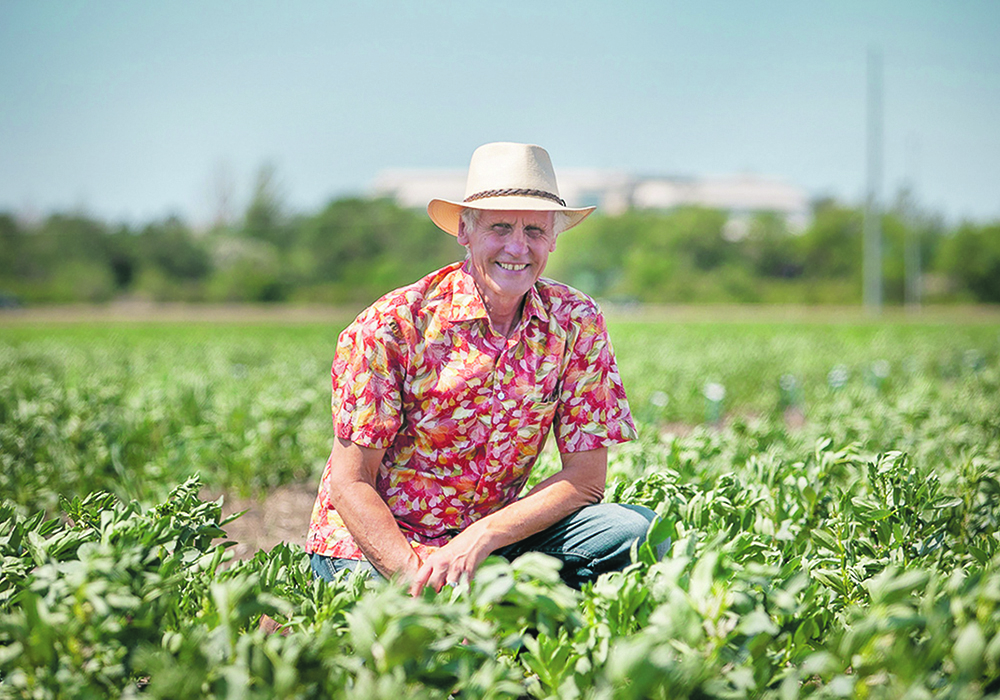Academics at the University of Saskatchewan say fababeans could soon become an important option in sustainable crop rotations, thanks to new research that will make the crop safer to eat.
Earlier this year, a research team that included academics from the U of S, published a paper explaining how fababeans produce vicine and convicine, a pair of compounds that can cause severe health problems for an estimated 400 million people around the world.
Vicine and convicine have been the Achilles heel of fababeans for centuries, says U of S plant breeder and geneticist Albert Vandenberg, who co-authored the paper recently published in the journal Nature Plants.
Read Also

Saskatchewan throne speech promises strong economy
Saskatchewan’s legislative agenda for the coming year will focus on meeting the challenges of new world trading relationships, said the speech from the throne.
For people deficient in a certain enzyme, the two compounds can damage red blood cells and trigger a rare and potentially fatal blood disorder known as favism.
Concerns over favism were first raised about 2,500 years ago by the Greek philosopher Pythagoras, who discouraged his followers from eating fababeans.
More recently, favism has thrown an obstacle in front of widespread fababean cultivation and has limited the crop’s use in the food and protein processing industries.
“It’s been kind of like the boogie man factor for the food industry because once you extract the protein, you also concentrate the vicine and convicine,” Vandenberg explained.
Because an estimated 400 million people worldwide are genetically pre-disposed to favism, food processors have been reluctant to invest too heavily in fababean based products or processing systems.
But that is beginning to change.
With a new understanding of how vicine and convicine are produced, geneticists and plant breeders are now developing new fababean lines that are free of the potentially harmful compounds.
About five years ago, Vandenberg and other researchers at the U of S discovered the gene responsible for vicine production in fababeans and identified a reliable genetic marker that allowed them to eliminate the gene from breeding material.
Vandenberg said the fababean breeding program that he leads at the U of S has now eliminated vicine and convicine from all experimental lines and cultivars.
Going forward, concerns over favism should be a non-issue. By next year, there should be enough seed for new vicine-free fababean varieties to plant nearly 100,000 commercial acres in Western Canada, Vandenberg said.
After that, acreage could quickly increase to a million acres a year and beyond, he believes.
“Now, we can reduce 99 percent of the vicine and convicine, and using sequencing and genomics, we should be able to zero in, to shut it down, 100 percent.”
Vandenberg said fababeans have the potential to be the next transformative agricultural crop in Western Canada.
The crop has protein levels higher than field peas and it fixes from the atmosphere 80 percent of the nitrogen it requires. Field peas fix just 30 percent of their required nitrogen.
“It’s an amazing crop for nitrogen fixation,” he said. “There’s no other annual legume that fixes nitrogen like the fababean.”
With heightened concerns about environmental sustainability, global climate change and the need to reduce agricultural emissions by limiting commercial fertilizer use, the appeal of a crop that fixes 80 percent of its own nitrogen is obvious.
In addition, the crop is not affected by aphanomyces, a soil borne disease that is spreading across the West and has the potential to severely limit production of field peas and other pulse crops, especially in wet years.
“It’s going to be very important for the future here because it doesn’t get aphanomyces root rot,” Vandenberg said.
“Aphanomyces is a long-term issue so we need to expand our crop rotations between peas and lentils to eight years … otherwise it’s never going to go away and there’s not going to be any easy fix, either genetically or bio-chemically. So, fababean is going to be important.”
On the consumption side, the elimination of vicine and convicine from the fababean equation has opened up a new world of potential.
Protein extractors are looking for new crops that can be processed efficiently and inexpensively to meet the growing global demand for value-added protein concentrates.
Vicine-free fababeans are a natural fit and have generated significant interest from extraction companies looking for a crop that has a neutral taste profile and can be processed at a relatively low cost.
“Everybody in the processing industry likes fababean because of its environmental footprint,” Vandenberg said.
But they also like fababean because of its neutral flavour profile. Because it does not require deflavouring to eliminate unpalatable tastes, processing requirements are simplified and costs are comparatively low.
Historically, fababeans played a key role in feeding the Roman Empire, Vandenberg said.
Along with wheat, which nourished the Roman Empire’s armies, fababeans formed the backbone of many crop rotations in the Mediterranean region because of their nitrogen-fixing capabilities.
“It was a cornerstone — basically the fertilizer system — of the Roman Empire,” he said.
With the elimination of vicine and convicine from new varieties, fababeans could once again play an important role in modern agriculture.
Expanded production in Saskatchewan and other parts of Western Canada could be the first step in a widespread revival.
In Saskatchewan, “it’s going to start in the northeast but I think we can move fababean production further south by quite a bit as well,” Vandenberg said.
“When there’s a normal rainfall year, I think you’ll be able to grow them in the south quite successfully.”
















